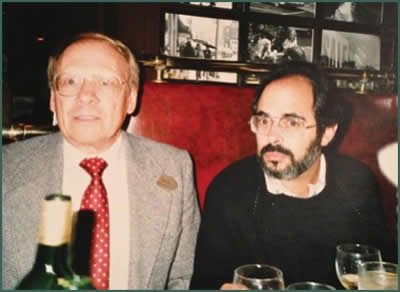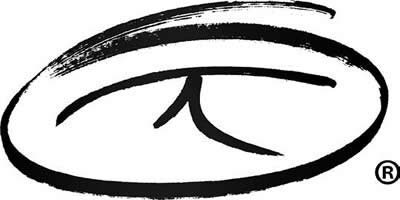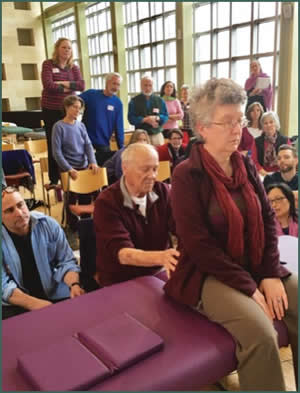Positive Health Online
Your Country

Deeper Massage – Zero Balancing The Body’s Energy and Structure
by David Lauterstein(more info)
listed in zero balancing, originally published in issue 242 - November 2017
I had been practicing and then teaching Deep Massage – The Lauterstein Method - for four years when I first met Dr Fritz Smith, the founder of Zero Balancing. At the time, I had trained in Swedish and sports massage, in Structural Bodywork, an offshoot of Rolfing, cranio-sacral therapy, in shiatsu, and more. Yet I had the distinct impression that there was something in the person that I wasn’t touching at all! What could that have been?

Fritz Smith MD and David Lauterstein at the AMTA Convention 1986
photo by David Lauterstein
This first meeting with Dr Smith was in 1986 at the National Convention of the American Massage Therapy Association in Washington DC. His lecture there gave me essential answers to my wonderings and, like any superb teacher, he gave me new questions to ponder. Over the last 30+ years, while further developing Deep Massage and teaching world-wide, I have incorporated the insights and methods of Zero Balancing.
I would like to share some background and resulting ideas about bodywork and human being that I believe will help in your practice, whatever forms of therapeutic work you are interested in or practice.
First, an assumption here is that health is not only a matter of physical structure but also a matter of how we feel and what we think. In other words, health is a matter of energy as well as structure.

From Albinus’ Tabulae sceleti et musculorum corporis humani (London, 1749)
Secondly, we know that soft tissue work is critical. Yet beneath the muscular system lies the skeletal system and neither system works in isolation. So we can anticipate deeper therapeutic results when we understand and address the skeletal system as well as muscles and fascia. This is greatly facilitated through the knowledge and practice of Zero Balancing.
Zero Balancing is a fascinating advanced bodywork which specializes in the balancing both the human energy field and its anatomical structure. The common ground between modern massage, bodywork and energy work is perhaps the most fertile within the entire mind-body realm. Virtually all studies of trauma indicate that healing involves more than the physical ‘fixing’. Equally it requires the resolution of accompanying emotional, mental or spiritual distress. However, the common ground between structural and energetic approaches to healing is notoriously difficult to map. Physical medicine for the most part has virtually nothing to say regarding the flow of energy. Energy work, on the other hand, all too often relies on unproven belief systems rather than tangible physical evidence. One may sympathize with the closet-mystic and genius, Ida Rolf, who, when asked why she worked with the connective tissue, fascia, answered with exasperation, “Because that’s what I can get my hands on!”
So perhaps the greatest question in holistic bodywork is - how can a therapist get his/her hands on both a person’s energy and on their physical structure? Today an answer to this question is being addressed elegantly by Zero Balancing. Founded in the early 1970s by Dr Fritz Frederick Smith MD Osteopath, Rolfer and Acupuncturist, Zero Balancing (ZB for short) provides answers and fascinating new questions in the search for bodywork’s holy grail, the unified approach to mind\body healing. Its theory reconciles the rigorous demands of Western science with the cosmological radiance of Eastern models of health.
As a hands-on skill it is an eminently teachable and non-invasive means to restore and maintain well-being. From thousands of reports its therapeutic impact is so profound as to evoke spiritual metaphors. For massage and bodyworkers, movement therapists, acupuncturists, psychotherapists and all manner of medical professionals, Zero Balancing provides practical access to both sides of the body\energy equation.
Modern physics informs us that a given phenomenon, be it atom, quark or galaxy, may be regarded as particulate matter or as quanta of energy. For example, we may see an ocean wave as an object, a thing, or, with a shift of perspective, we can recognize the wave rather as the movement or energy passing through the water. Energy and matter intraconvert in a cosmic dance of form and force. In Zero Balancing there is particular importance placed on the ‘interface’, when and where energy and structure meet. Think of the place where the wind meets the sail of a boat. In politics imagine the moment when a popular ‘movement’ may alter the form of government. Zero Balancing cultivates a highly developed sensitivity to the interface of the structure and energy of the therapist with the energy and structure of the client.
As with the great currents in the ocean, energy within the human body, while complex, moves in broadly definable ways. It is extremely important to know that in Zero Balancing the body substance containing the most matter, the skeletal system, is regarded as conveying the densest energy - just as the thicker 220 line delivers more ‘juice’ than the 110 in the electric wires of your house. To tap into this energy the Zero Balancing practitioner contacts the skeletal system. Its bony armature conveys the force of gravity though itself and assures our buoyancy within the gravitational field. This system also absorbs and conducts powerful forces of muscle contraction, impact, momentum, etc. as we move through our lives. Significantly, the skeleton lies deepest in our bodies, deeper than the voluntary layer of our muscles. We can consciously tighten our muscles, but the bones remain below our conscious awareness and control. Therefore, for the bones are reserved a subjective sense of ultimacy. “I feel it in my bones”, “bone-tired”, “chilled to the bone”. These expressions give experiential testimony to the bone layer as the repository for the deepest sense of being.
In Zero Balancing the skeletal system is understood as constituting the deepest and most dense energetic domain. The function of this domain is to connect us to nature. It is experienced as an essential part of us but not as a voluntary or conscious expression of self. Skeletal energy has more to do with the life we share on this earth than with the life we make through our individual efforts. It is part of the form which abides. Referred to in Eastern thinking variously as ‘ancestral chi’, ‘kundalini’, ‘sushumna, ida and pingala’, this energy runs vertically through us in three pathways: a main central or ‘universal life flow’ through the skull, spine, pelvis, legs and feet, the second vertical flow through the shoulders and the costo-vertebral joints which rejoins the main central flow at the pelvis, and the third vertical flow which branches out through the shoulder girdle to the arms and hands. It is to a great extent by recognizing the connection of these most fundamental energy flows with the skeletal system that ZB enables the practitioner to put hands on energy and structure in a dramatic, clear and powerful manner.
The second energetic domain has pathways that pervade the entire body. These are identified as the ‘internal energy flows’. This energetic domain allows us to function as individual egos or ecosystems. The deepest level of this domain is created by our literal movement in life. When we walk and move, we describe curves and spirals which resolve overall into a kind of three-dimensional figure 8. The dynamic energy of this figure 8 movement configuration nourishes and helps keep us integrated as individual beings. The middle level of our internal energy flow is housed within the soft tissues of the body. The middle level corresponds to the meridians of traditional Chinese medicine and the muscles, nerves, blood, organs, etc. of Western anatomy. The function of this layer is to direct the person’s energy toward the fulfillment of nutritional, mental, emotional and spiritual needs. The last and most superficial level of the internal energy flows is described in traditional Chinese medicine as the ‘wei chi’. The wei chi, a coarse and non-differentiated energy field lying just beneath the skin, functions to selectively repel or absorb certain vibrations and physical inputs from the world around us. If deficient, this energy field may allow our boundaries to be violated by what Chinese medicine characterizes as ‘pernicious influences’ which can be of a climactic, physical or psychological nature. The wei chi normally retains a resilient surface tension which enables us to maintain healthy and flexible boundaries. It corresponds anatomically and physiologically to immune functions, the skin and the superficial fascia.
As distinct from the main central and internal energy flows, ZB identifies the third primary energy domain as the more diffuse ‘background energy field’. This field has no form of its own - it permeates the entire body and the space surrounding it. The background energy field can be considered the vibratory backdrop or background music of the body. It may come to therapeutic significance since an acute or chronic trauma can imprint on this field, reducing its natural vibrancy and ability to freely respond to life’s changes. Normally the background energy field enables us to gracefully bounce back or flow along with the continually changing nature of everyday life.
To summarize the ZB energy model, there are three primary energy domains in the body corresponding to anatomical layers:
1. The universal life flow running vertically through the physical armature of our skeletal system that connects us, plugs us in, if you will, to the energy of life;
2. The internal energy flows at three levels - the figure 8 within the skeletal system, activated by the ‘cross-crawl’ pattern in walking and other everyday movements, the middle level of the soft tissues and meridians through which we manifest our individuality, and the superficial level of the wei chi through which we maintain the integrity of our boundaries.
3. The background energy field that permeates the space within and around the body - the vibratory backdrop of everyday life.

The Zero Balancing Fulcrum logo
The tool developed by Deep Massage and Zero Balancing used to affect these energetic domains and their interaction within the structure of the body is called the “fulcrum”. “Fulcrum” is defined by the American Heritage Dictionary as “a position, element or agency through, around or by means of which vital powers are exercised.” The ZB fulcrum is built by the therapist in such a manner that his or her energy and structure interface with the structure and energy of a client - touching with clarity and attention. In addition to this structural/energetic interface at least two other vectors of force are added to the fulcrum. This results in a complicated geometric form through which to affect the client. The therapist may, for instance, gently take up the slack from the whole body then traction and rotate at a joint. Or one may cradle the head and neck, then lift up in a graceful arc. Or, making contact with the ribs gently press into them with curved fingers, summarizing two or more vectors of force.
Once this complex touch is achieved, it is held. Noting that “a person cannot not react”, Dr Smith observed that a sustained fulcrum will often stimulate a deep reaction. Holding this space open is akin to quiet forms of meditation. While Feldenkrais work is spoken of as “awareness through movement”, Zero Balancing might be better described as “transformation through stillness.”

Dr Smith demonstrating seated evaluation of the sacra-iliac joint at ZB & Consciousness,
Newton, Massachusetts, 2016
Photo by Sara Feld
In a ZB session, fulcrums are applied in a specific sequence to the key joints and areas of energetic significance in the body such as the sacro-iliac, intervertebral, costovertebral and tarsal joints. The particular nature of these joints, called in ZB terminology “foundation joints”, is that they function primarily in balancing, absorption and conduction of energy and force vertically through the body rather than being involved in locomotion. These joints have a limited range of motion. For instance, the small bones in the foot - the talus, calcaneus, navicular, cuboid and cuneiform bones - have limited movement between them. Importantly there is no muscle running from one of these bones to another. Therefore with limited voluntary movement and limited awareness (since they lack the proprioceptive input from the muscles) much of the dysfunction which occurs at these joints will remain unconscious, experienced, if at all, in a generalized sense of dis-ease, compression or instability. Since these joints play such a crucial role in structural integrity and energy transmission, small changes here will have an amplified consequence throughout the whole being. As chaos theory has shown, if one understands the structure and dynamics of a system, small, well-targeted changes may have dramatic, system-changing impact.
How does one recognize change of energy and structure down to the level of bone? To this end Zero Balancing has evolved a very specific set of observation skills. With the use of fulcrums, it has been observed, clients will periodically enter a ‘working state’ in which the body/mind/spirit responds, reorganizes and reintegrates during the session.
The observable aspects of this working state are called ‘working signs’. Observing for working signs helps to refine the exact timing, location and quality of each fulcrum. They enable practitioners to track and stay in touch from the outside with the depth and quality of clients’ inner experience during the session. Some of the major working signs are rapid eyelid fluttering and the ‘working breath cycle’ characterized by the client’s breathing becoming more shallow, then an exaggerated breath, followed by the resumption of normal breathing. Other major signs include, relaxation of facial and jaw tension, quality of voice vitality, borborygmus (bowel rumblings), swallowing and involuntary movements, such as made when one temporarily jerks, falling into then out of a sleep state. Learning to observe and respond to the working signs takes a significant amount of guesswork out of the monitoring clients’ reactions to this energetic and structural work.
A Zero Balancing session is performed with the client clothed and lasts approximately thirty minutes. After a brief orienting interview, the practitioner does a seated evaluation to gather preliminary information from the ribs, lower back and shoulders. The client then lies down. At an easy pace, through a variety of evaluative movements and fulcrums, the practitioner then addresses key joints and soft tissues in the low back, pelvis, hips and feet. Attending all the while to working signs, the practitioner then proceeds to the upper body. Evaluating and balancing first the ribs and neck, then the trapezius, shoulder joint scapulae, and arms, the practitioner completes the upper body work with special attention to the sub-occipital region, if needed, and some fine-tuning through ‘touch-up’ fulcrums. Then with brief ‘closing’ fulcrums to the thorax, ilia, backs of knees, and, finally a longer integrating fulcrum through the feet and legs, the practitioner disengages and waits for a few moments as the client settles into his/her new experience.
Zero Balancing is taught primarily as a set of high-level skills to health practitioners rather than as an entry level skill. The insights and abilities stimulated by ZB therefore enrich whatever one’s scope of practice is. Most who study it freely incorporate ZB into their massage therapy, body/movement work, counseling, acupuncture, or medical practice. Training programs are offered throughout the world by the Zero Balancing Associations, the Upledger Institute, and by individual teachers.
When describing the impact of ZB it is important to remember that each client is naturally unique and ultimately unpredictable in his/her response. Fritz Smith commonly counsels students to avoid the attempt to make someone have a certain experience, saying, “Raise a flag and see who salutes.” I particularly recall his response to a student’s repeated inquiries regarding the intention of various fulcrums, saying, ” I don’t work with intentions, I work with my fingers.” Nonetheless it is certainly reasonable to ask - what are some of the common intentions, ranges of response and therapeutic benefits to Zero Balancing?
Because the healthy function of the skeletal system is one of the theoretical bases for ZB and the literal basis underlying the muscles and fasciae of the body, soft tissue pain and dysfunction are often relieved through Zero Balancing. Headaches, neck and shoulder pain, low back pain and many other physical symptoms may be dramatically affected by ZB. Similarly, alignment will be improved through the attention paid to foundation joints. Clients report experiences of a new uprightness and enhanced relationship of their body to gravity. Feelings of being taller, lighter with a greater fluidity to each of one’s everyday movements are commonly reported. Although more difficult to prove, it is certainly hoped that ZB, as it brings the deepest structures and energetic domains of the body into graceful balance, will have a preventative or ameliorative impact on disease and degenerative processes in the body.
Psychologically, sustained or acute trauma can imprint on the background field, impede or destabilize the internal energy flows, and may, ultimately, affect the vertical energy flow. By emphasizing fulcrums into the key energetic and structural domains crucial to the individual, Zero Balancing can help balance the psyche. Experientially, clients report a heightened sense of calmness and a lessening of needless anxiety. Occasionally the ZB client may experience the release of long-held emotions or memory as the tensions of past stresses are relieved. A restored sense of hope and power is commonly reported. This likely stems from sustained experiences within the working state. Living in a sustained manner in an expanded state of body and mind allows one to gain a more flexible, expansive perspective on problems that in one’s everyday state of mind may seem insuperable or overwhelming.
For many practitioners and clients the most intriguing and revolutionary aspect of Zero Balancing is its spiritual impact. Intriguing because it is at once exciting and difficult to believe, given our materialistic culture and upbringing, that hands can touch another person’s spirit directly and hold, amplify or balance it.
In our culture today, many people are engaged in a search for a more harmonious and sustainable way to live. There is a hunger for deeper feelings of clarity and connection. ZB is revolutionary in that it provides a dramatic and body-felt amplification of this experiential realm. It provides a much needed and direct experience of living in sustained harmony, clarity and connectedness. ZB’s theory and practice here have some essential contributions to make toward the urge and need for wisdom in our age.
The dense energy domain, which ZB primarily focuses on, is experienced as deep within us but not as a personal attribute. It has more in common with the ‘élan vital’, that vital energy or spirit which infuses us and enables us to live. ZB has discovered that this domain is accessible through the skeletal system, particularly the foundation joints. To have identified an anatomical locus for spirit upsets the monopoly which religion has had on spiritual experience. Now spirit is accessible reproducibly and every day through an enlightened approach to anatomy. Anyone can access spirit without having to subscribe to any particular belief system. This allows for the spread and democratization of spiritual experience that is essential to our age if we are to move beyond egotistical lifestyles and the politics of disintegration.
Zero Balancing - Body / Mind / Spirit Freedom
Freedom is a word that I have not heard used much since the sixties - those incredibly inspiring times in which, to paraphrase the Freedom Singers, many groups of people were walking and talking with their minds and hearts set on a higher level of integration for mankind. Perhaps freedom fell into disuse because we simply lacked the deeper technologies for its achievement. During my first course with Dr Smith I leaned over to him and whispered emphatically, “This is really the science of Samadhi!” His whisper back, in disarming and comical modesty was, “Yes, but don’t tell anyone!” Samadhi implies an enlightened stillness of mind, a body and spirit at peace. Zero Balancing frees the background field from past vibrations that linger in time beyond their usefulness; frees the internal energy flows from past and present stressors which needlessly impede our life function; and balances the skeletal system thus freeing the core/source energy of our lives. All this work heightens the perception that the source of our happiness lies not in the temporary satisfactions of the ego, but rather in the appreciation of the life we share and in the honouring and re-creation of this life we share on this earth at higher and higher levels of structural and energetic integrity. ZB, through its energy model, simplicity of transmission and practice, and powerful therapeutic impact represents a qualitative step in this integrative process.
So welcome to what may be a happy moment in the growing science of Samadhi. And welcome, bodywork, fully to the 21st century! And welcome finally to Zero Balancing which may help us all give new substance and new power to the dream and to the expression - Free At Last!
Comments:
-
Sara Jennett said..
Thank you David, fascinating! And very lucidly explained, most helpful. Shall be putting in a link from my website!